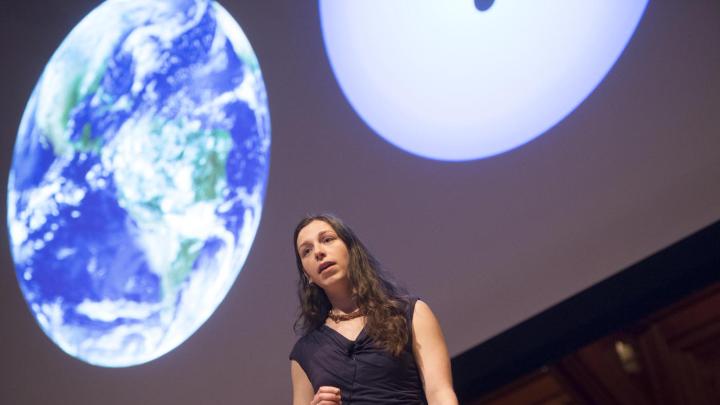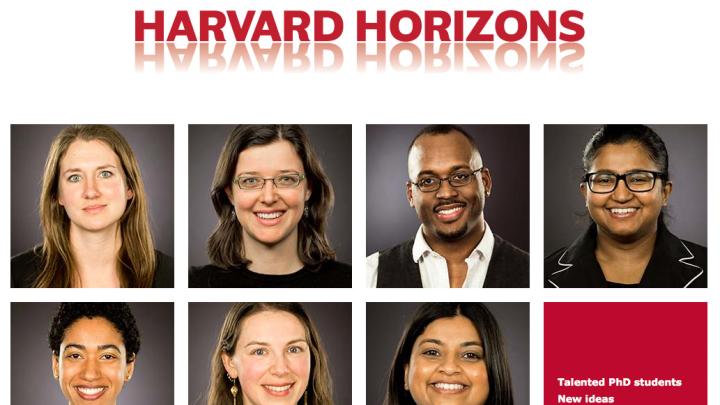Giving five-minute talks on subjects ranging from lizards to a theory of “micro-activism,” seven Harvard Horizons scholars presented their work at Sanders Theatre on May 6. They had been chosen from a pool of graduate student applicants who submitted written synopses of their work, and short videos of themselves speaking about it, to a faculty committee. The symposium was the culminating event of the resulting 10-week training program in presentation skills. Harvard Horizons was founded in 2013 to highlight some of the most promising research from the Graduate School of Arts and Sciences (GSAS); it aims to do so by coaching Ph.D. candidates on how to share their work with a broad—and live—audience.
Two of the presenters came from the organismic and evolutionary biology department. Shane Campbell-Staton spoke about his research into how green anole lizard populations weathered the 2013 polar vortex, rapidly adapting to climate change. His fellow student Leonora Bittleston described how she collected pitcher plants from far-flung rainforests in North America and southeast Asia, and then analyzed the interactions among the fungi, protozoa, and bacteria housed in the plants, to uncover what she called “patterns to the organization of life.” Widusha Illeperuma, of the materials science and mechanical engineering department, introduced the audience to “tough hydrogels”—composed of 90 percent water and two polymer networks—and their potential use in cartilage replacement, artificial muscles, and flame-retardant gear. The sole representative from the humanities, philosophy student Céline Le Boeuf, ’07, outlined strategies for countering prejudicial racial responses. Data analysis done by Prachi Sanghavi, who studies health policy, uncovered how medical interventions given by staff in ambulances equipped with more advanced technology actually tended to have worse outcomes for patients.
In the realm of anthropology and human evolutionary biology, Bridget Alex asked, “Why are we the only humans left?” She presented research on contact between Neanderthals and modern humans in northeast Europe, the Balkans, and the Levant—regions largely overlooked, she joked, “perhaps because researchers like to go where the wine is best”—and explained other factors skewing scholarly understanding of history. Researchers have often mistaken bones used in butchery with bones gnawed by hyenas, for example, or charcoal from manmade fireplaces with that from natural fires; subsequent contamination may further affect the accuracy of carbon-dating results. Using more rigorous sampling, and new chemical procedures that can detect and remove contaminants, Alex has found that there was a 5,000-year period in which humans and Neanderthals overlapped in the Balkans. We still don’t know why we survived and why they died out, she said, but “These results give us one time and place to look for the answer.”
In contrast, the astronomy department’s Elisabeth Newton looks up, not down—and not at humanity’s past, but perhaps at its future. She specializes in red dwarf stars, which emit most of their light in the infrared spectrum and are thus too faint to be seen without a telescope. The red dwarf is the most abundant and, until recently, least-studied type of star, explained Newton: “Theoretical models do not explain its properties, like size, age, or spin.” Through observation and spectroscopy, she analyzed 600 nearby red dwarves to determine the relationships among such features as temperature, diameter, and chemical composition. “For many of them, it’s the first time we’d learned about their properties,” she pointed out.
Because astronomers draw conclusions about surrounding planetary systems via their stars, knowing more about the latter can give a stronger sense of which systems have habitable planets. Newton gave the example of red star Kepler-372, which she determined was 15 percent larger than previously thought. This meant that its orbiting planets were also 15 percent larger—which could make the difference, she said, between a rocky, earthlike planet and one with gas levels more akin to Uranus or Neptune. “It is around the red dwarf stars that can’t be seen that we have the best prospects for finding and studying habitable rocky worlds,” Newton concluded. “It’s the planets orbiting these stars whose atmospheres we’ll be able to study with the next generation of telescopes, and on which we’ll first have the capability of finding signs of life.”
One of the eight scholars, applied physics student Yu Lei, did not take the stage, for what GSAS dean and master of ceremonies Xiao-Li Meng alluded to as “legal reasons.” (That lawyers from another institution got involved, Meng joked, was a sign of just how exciting the research was. Answering questions over email, Lei explained that due to complications with the patent submission process and the corporate sponsorship of his research, he could not disclose details about his work at the public event.)
In his work, Lei combined genetics and nanotechnology to design tiny sensors—DNA strands, housed in a calcium carbonate shell—that scientists could collect, and read, to learn about environmental conditions in areas where the particles were released. This technology is currently being used by the oil industry to track the flow of oil deep underground. In his email, Lei also elaborated on other potential uses for his nano-sensor, such as collecting data on pH and temperature underground for geographical studies, or "in body sensing and drug delivery."
Lei did speak, and enthusastically, at the end of the ceremony—to praise the experience of learning speaking skills alongside “a group of fantastic people,” and to thank the mentors who had helped his cohort for the past four months.










